80 Most Popular Long Neck Dinosaurs Ever Recorded in History
Do you know the largest creatures ever walk on the earth were the long tailed and long neck dinosaurs which were called as Sauropods?
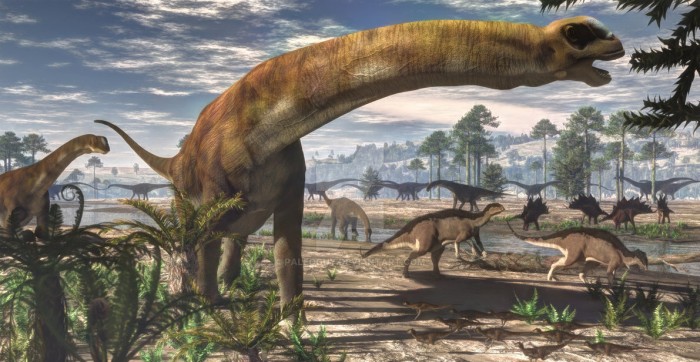
Collectively, the long necks of the dinosaurs were thought to have been used for hunting high in trees. It was quite easy to memorize the sauropods (long-necked dinosaurs) because all of them possess common characteristics like long necks & tails, small heads, four thick, pillar-like legs, and herbivorous nature.
Check out who are the most popular long neck dinosaurs on the list here.
1. Diplodocus
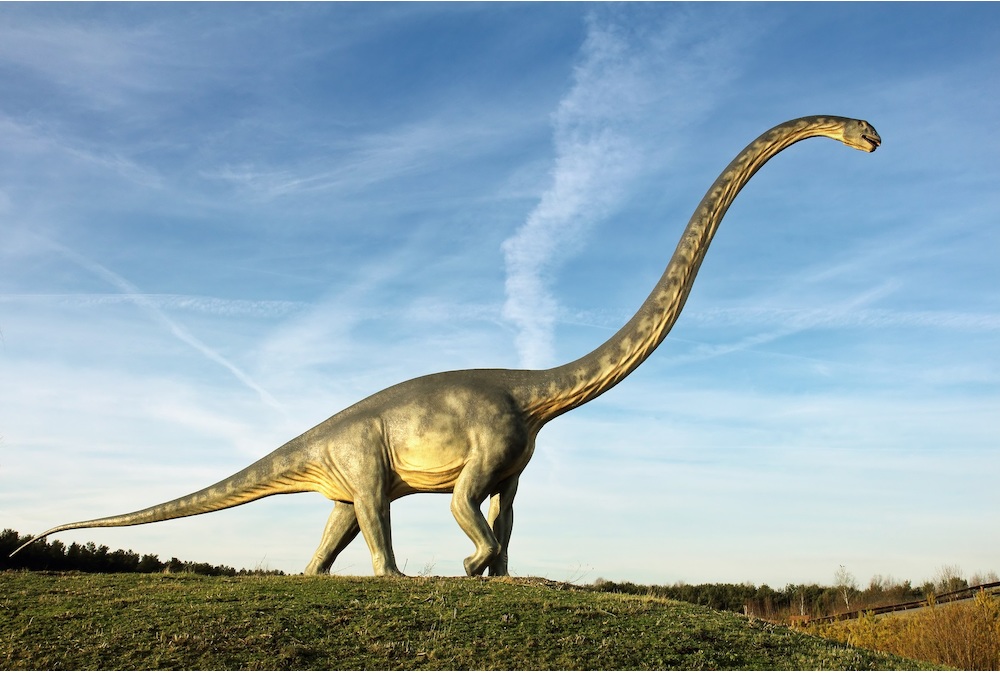
Diplodocus lived 145-150 million years ago. It was herbivorous and had four large, sturdy legs, a whip-like tail, and had a super long neck. The body of this huge creature was balanced by its long, heavy tail.
The neck of the Diplodocus could reach more than 20 ft, and its tail had 80 vertebrae. The long neck of this Sauropod was almost filled with air making their necks very lightweight. Diplodocus measures 99 ft in length and nearly 16-18 tons in weight. They were first identified in North America in 1877.
2. Brachiosaurus
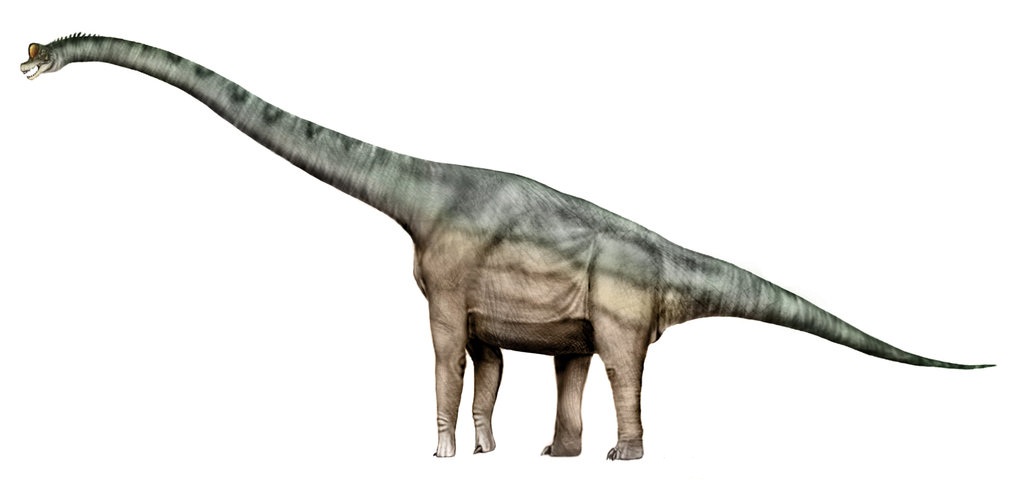
A genus of Sauropod, Brachiosaurus lived 150-8 million years ago. The name Brachiosaurus means arm lizard. The name was chosen because its forelimbs were longer than its hind limbs. It was a warm-blooded animal as the enormous size allowed them to keep their body at high temperatures.
Brachiosaurus had a 30ft long neck, 41 feet tall, and measured more than 90 tons. These long-necked creatures lived in Africa and North America during the early Cretaceous periods. (1.1)
3. Camarasaurus
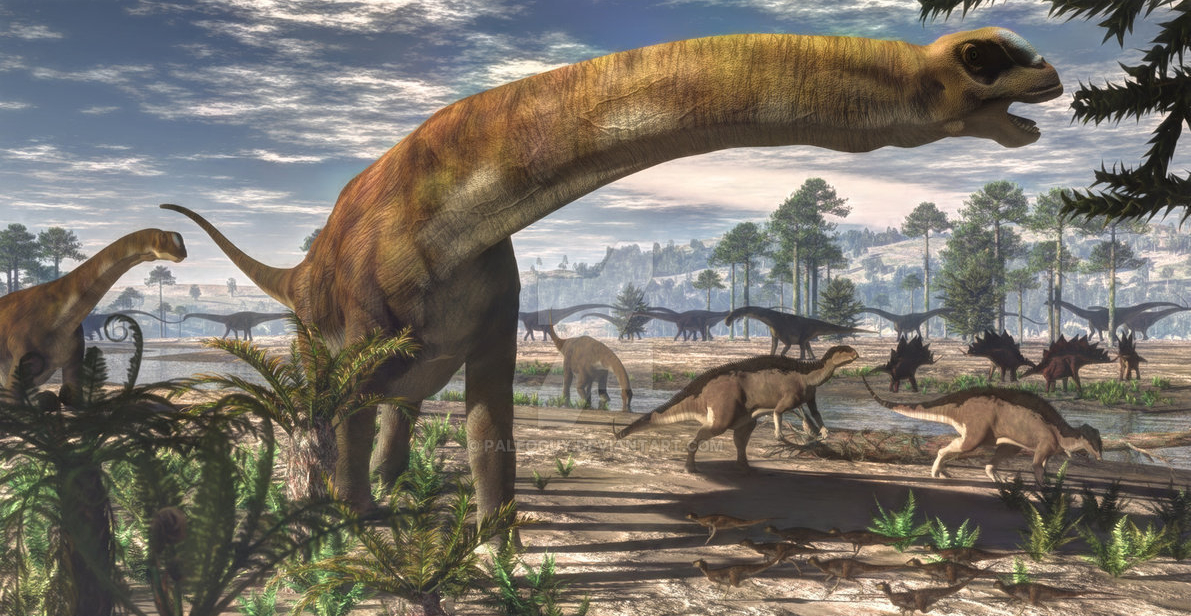
A Genus of quadrupedal dinosaurs, Camarasaurus lived 150 million years ago during the Jurassic Period. It was called a Camarasaurus because of its structure, like the chambered lizard.
Just like a bird, it was noted that these long neck dinosaurs were herbivores and swallowed stones to crush their food. It weighed as much as 4 African elephants, i.e., 20-30 tons, and was 60-65 feet long. It was founded in 1877 in North America.
4. Alamosaurus
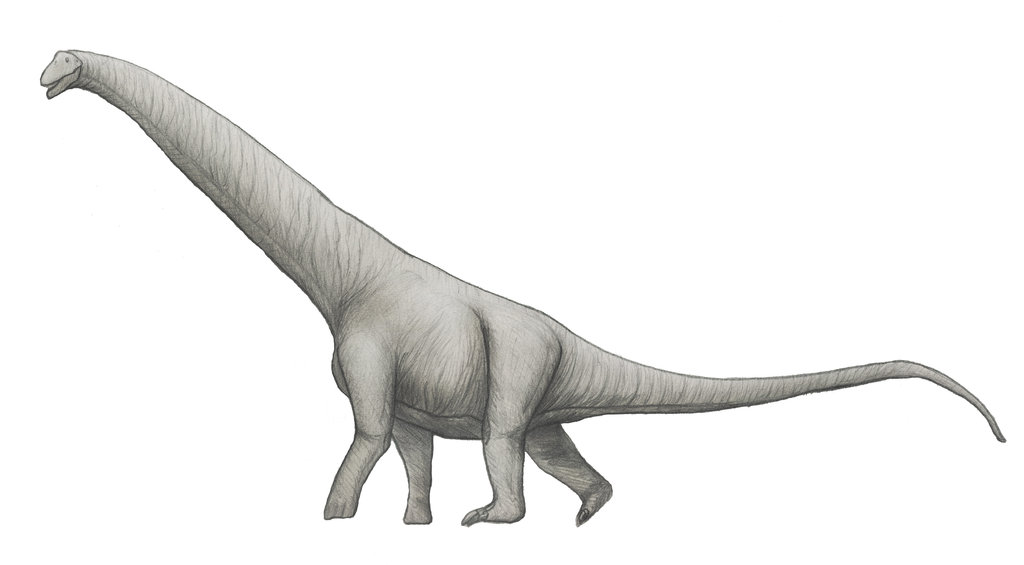
A genus of titanosaurian sauropod, Alamosaurus, lived 73 million years ago during the Late Cretaceous period and became extinct. This dinosaur was three stories high and always noted in large herds of thousands of dinosaurs.
Alamosaurus was approximately 28 feet high, 75 feet long, and weighed more than 33 tons. This popular long neck dinosaur was first discovered in New Mexico in 1922 and was named by paleontologist Charles W. Gilmore. It used their long necks to feed on ground base plants and had a long tail to use as a whip. (1.2)
5. Argentinosaurus
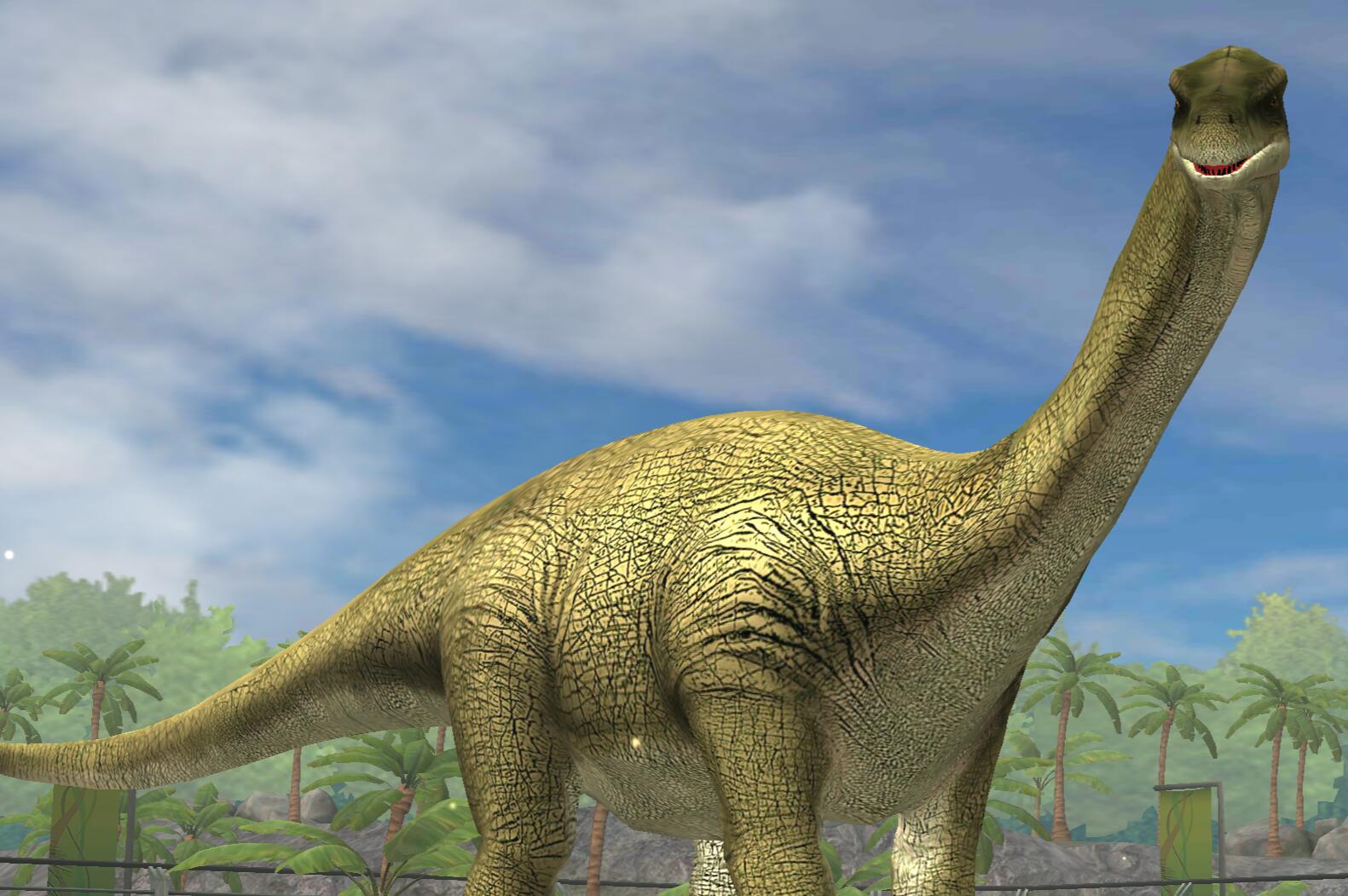
It lived 95-100 million years ago. A genus of titanosaur, Argentinosaurus, had weighed close to 100 tons. It hatches from an egg, and this young species grows to more than 120 ft. That means the young dinosaurs grow 25,000 times their original size until they reach adulthood.
You can’t even imagine how fast they can run. They had speed as fast as the turtle. It was the popular long neck dinosaur to exist beyond the Jurassic Period.
6. Apatosaurus
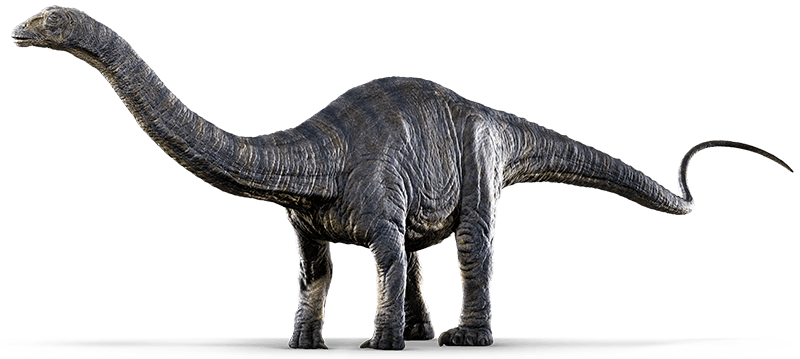
“Apatosaurus” typically means “deceptive lizards’. They belong to the Animalia kingdom and are a genus of herbivorous sauropod dinosaurs from North America at the time of the late Jurassic period. They existed 152 to 151 million years ago during the early Tithonian age. Now, they are nothing more than fossils in the Morrison formation of modern-day Colorado, Oklahoma, New Mexico, and Utah in the United States.
They measured about 21-22.8 m(69-75ft) in length, the average mass of 16.4- 22.4 tons. They are a member of the family Diplodocus, which shared the characteristics with sauropod dinosaurs. They are among one of the longest creatures who walked the earth.
7. Ultrasaurus
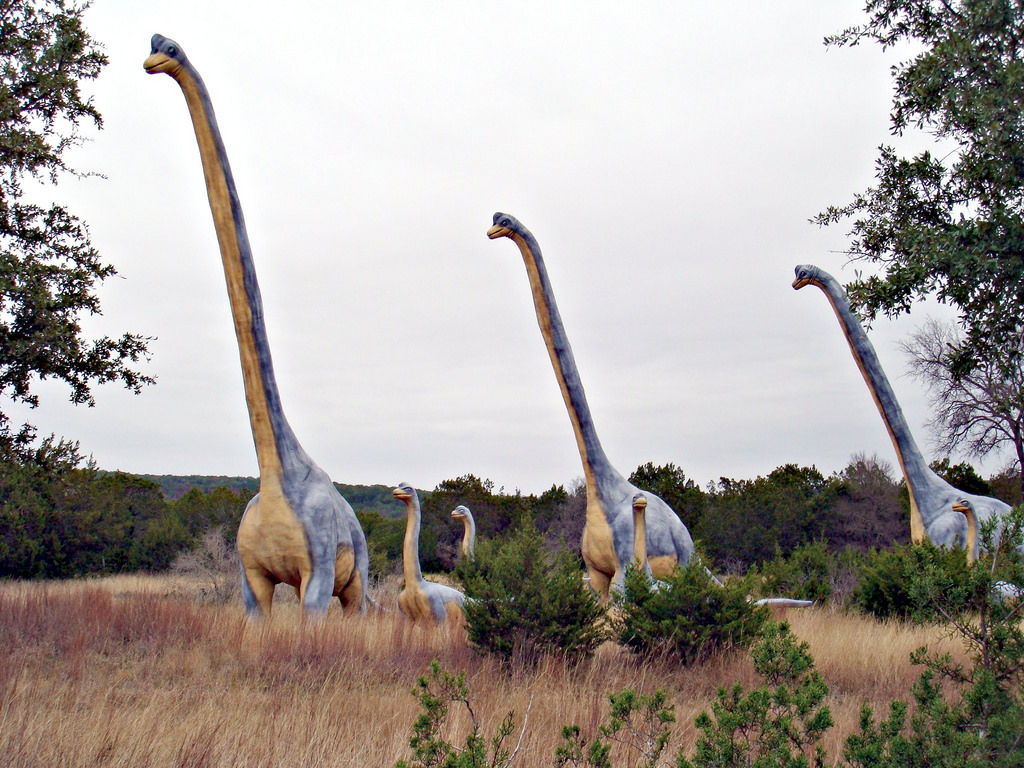
Ultrasaurus is also a genus of Sauropod dinosaurs. They were first discovered in South Korea by Haang-Mook Kim. As their existence has not been proved, they are classified as nomen dubium. They lived 100 to 110 years ago at the time of the Aptian and Albian stages of the Early Cretaceous.
8. Brontosaurus
Brontosaurus, which means a thunder lizard, is a genus of huge quadruped sauropod dinosaurs. It consists of three species: B. excelsus, B. yahnahpin, and B. parvus. It had a long, thin neck and a small head adapted for a herbivorous lifestyle. Also, it had a bulky, heavy torso and long, whip-like tail.
They belonged to the Late Jurassic epoch in the Morrison Formation of present-day North America (Laurentia) and became extinct later on by the end of Jurassic. This archetypal dinosaur is one of the best-known that has been featured in postage stamps, various media, and pop culture.
9. Barosaurus
Barosaurus, which means heavy lizard, is an enormous plant-eating dinosaur with a long neck and tail. Its remains trace back to the Morrison Formation from the Upper Jurassic period of Utah and South Dakota.
10. Amphicoelias
Amphicoelias, which means biconcave, is a genus of 82-ft sauropod dinosaur that existed nearly 150 million years ago during the Tithonian (Late Jurassic Period) in present-day Colorado. It has long and thin hindlimbs, while its forelimbs are proportionally longer than relatives.
11. Supersaurus
Supersaurus, which means super lizard, is a genus of diplodocid sauropod dinosaur that was from the Late Jurassic period and dwelled in present-day North America. Vivian Jones of Delta discovered the type species S. vivianae in the middle Morrison Formation of Colorado back in 1972.
Among the largest dinosaurs known, Its fossil remains came from the Brushy Basin Member of the formation, which dates back to over 150 million years ago. Another species, S. lourinhanensis, is from Portugal and dates back to a similar period.
12. Malawisaurus
Malawisaurus, which means Malawi lizard, is a genus of titanosaurian sauropod dinosaurs. It is from present-day Africa, particularly Malawi, and North America, especially Brazil, during the Aptian-Cenomanian ages of the Early-Late Cretaceous Periods.
Louis L. Jacobs and his colleagues named it Malawisaurus. And it was relatively smaller than typical sauropods, with a length of about 52 feet and weight nearly 10 tons. The vertebrae from the middle part of its tail had elongated centra.
13. Vulcanodon
Vulcanodon, which means volcano tooth, is an extinct genus of the sauropod dinosaur from the Early Jurassic of southern Africa. Discovered in 1969 in present-day Zimbabwe, its only known species is V. karibaensis.
One of the earliest and basalmost sauropods, it was considered the earliest known and one of the most primitive sauropods. It was a quadrupedal, ground-dwelling herbivore that was relatively small and 36 ft long.
14. Limaysaurus
Limaysaurus, which means Limay lizard, is a genus of single species of rebbachisaurid sauropod dinosaurs from the mid-Cretaceous period, which was nearly 99.6-97 million years ago, in present-day South America. It weighed 7 tonnes and 50 feet long.
15. Barapasaurus
Barapasaurus, which means “big-legged lizard,” is a genus of basal sauropod dinosaurs dating back to the Early Jurassic epoch in India. One of the earliest and completely known sauropods, it originated from the lower part of the Kota Formation, which is from the Sinemurian and Pleinsbachian stages of the early Jurassic.
16. Ohmdenosaurus
Ohmdenosaurus, which means Ohmden lizard, is one of the earliest and smallest primitive sauropods. It is a genus of herbivorous dinosaur from the Lower or Middle Toarcian age of the Early Jurassic in present-day Ohmden, Germany. It is believed to have lived in the region of Bohemia.
17. Opisthocoelicaudia
Opisthocoelicaudia is a genus of sauropod dinosaur of the Late Cretaceous period from the Gobi desert, Mongolia. Its body is estimated to be ranging from 8.4 to 25.4 tonnes in several studies. It had a barrel-shaped body, on four columnal limbs and a long neck and tail.
18. Jobaria
Jobaria is a genus of sauropod dinosaur that dwelled during the mid-Jurassic period (161-167 million years ago) in present-day Niger. Currently, it is the only valid sauropod from the Tiouraren Formation, where it was discovered in the fall of 1997. It is named after a local mythical giant beast named Jobar.
19. Ampelosaurus
Ampelosaurus is a titanosaurian sauropod dinosaur that is from the Late Cretaceous Period of present-day France. Not only does it have a long neck and tail but also armor in the form of osteoderms. It was believed to be 49-52 feet long and weighed 8000 kg. It is one of the most well-known dinosaur species from France.
20. Spinophorosaurus
Spinophorosaurus, which means spine-bearing lizard, is a genus of sauropod dinosaur that hailed from the Middle Jurassic period of present-day Niger. It is 43-46 feet long, weighing seven metric tons. It is either classified as a basal sauropod or inside Eusauropoda.
21. Euhelopus
Euhelopus is a genus of sauropod dinosaur that belonged to the Early Cretaceous period (113-129 million years ago) and was discovered in present-day Shandong Province in China. A huge quadrupedal herbivorous, it had a relatively complete skull and longer forelegs than hind legs, unlike the typical sauropods. Its discovery proved significant in paleontology as it represented the first dinosaur found in China.
22. Giraffatitan
Giraffatitan, which means titanic giraffe, is a genus of sauropod dinosaur that hailed from the late Jurassic period. They were considered the largest of all dinosaurs until the titanosaur and sauroposeidon surpassed it in terms of weight and height. It is 72-74 feet long, 39 feet tall, and 15-78.3 tonnes by weight.
23. Antetonitrus
Antetonitrus is a genus of sauropod dinosaur that used to exist during the Early Jurassic period and was found in the Elliot Formation of South Africa. One of the oldest known sauropods, it was a quadrupedal herbivore.
24. Kunmingosaurus
Kunmingosaurus, which means Kunming lizard, is a genus of sauropodomorph-dinosaur from the late Jurassic period. It was discovered in 1954 in Lufeng Formation, Wudung, Yunnan Province, China. It had a deep head and lower jaw having spoon-shaped teeth.
25. Breviparopus
Breviparopus is the name of an ichnogenus of dinosaur made by an unknown genus of a sauropod. It was discovered in the 1979 spring in the Atlas Mountains of present-day Morocco. Though contentious, it is believed to be one of the largest dinosaurs. They are dated to the Jurassic period.
26. Isanosaurus
Isanosaurus, which means Isan lizard, was a sauropod dinosaur found in the dark red sandstone of the Nam Phong Formation near the village of Ban Non-Thaworn in Chaiyaphum Province, Thailand. One of the oldest known sauropods, it dates back to nearly 210 million years ago during the Late Triassic epoch.
27. Rhoetosaurus
Rhoetosaurus, which means Rhoetos lizard, is a genus of sauropod dinosaur from the Jurassic period. One of the best-known sauropods, it was discovered in the Walloon Coal Measures at the Durham Downs Station near Roma in central Queensland, present-day Australia. It weighed 9 tonnes and was about 49 feet long.
28. Zby
Named after Georges Zbyszewski, who studied the geology and paleontology of Portugal, Zby is an extinct genus of turiasaurian sauropod dinosaur that hails from the Late Jurassic epoch. It was discovered in the Lourinhã Formation in central-west Portugal.
29. Kotasaurus
Kotasaurus, which means Kota Formation lizard, is a genus of sauropod dinosaur from the early Jurassic period. Found in the Kota Formation of Indian state Telangana, it was a large, quadrupedal herbivore with a long neck and tail. One of the most basal sauropods, it weighed 2.5 tonnes. Its skeletal mount is displayed at the Birla Science Museum, Hyderabad.
30. Amygdalodon
Amygdalodon was a genus of a basal sauropod from the Middle Jurassic period. Its fossils have been found in the Toarcian Cerro Carnerero Formation, Argentina. A quadrupedal dinosaur: it weighed 5 tonnes and was 39 ft long and 13 ft tall.
31. Dinodocus
Dinodocus, which means terrible beam, is the genus of a sauropod dinosaur. Richard Owen named it in 1884 and noted on the fossils in 1841. In 1840, HB Mackeson discovered its holotype.
32. Datousaurus
Datousaurus, which means Big-head lizard, was a herbivorous dinosaur from the Middle Jurassic period. Named by Dong Zhiming and Tang in 1984, it was discovered from the Lower Shaximiao Formation in Dashanpu, Zigong Sichuan province, China. It was about 49 feet long and had a deep, large skull.
33. Cetiosauriscus
Cetiosauriscus was a genus of sauropod from Callovian (Middle Jurassic Period) discovered in the marine deposits of the Oxford Clay Formation in present-day England. It was a herbivore having 49 feet in length and 4-10 tonnes of weight.
34. Shunosaurus
Shunosaurus, which means Shu lizard, is the genus of sauropod dinosaur that hailed from the Late Jurassic (Oxfordian) beds in the Sichuan Province in China. Its name is derived from Shu, an ancient name for the Sichuan province. Its first-ever fossil was discovered in 1977. It is estimated to be 31 ft long and three metric tons by weight.
35. Saltasaurus
Saltasaurus, which means lizard from Salta, is a genus of titanosaurid sauropod dinosaur that belongs to the Late Cretaceous period. Discovered in the Lecho Formation layer in present-day Argentina, it was identified by a relatively short neck and stubby limbs. It was the first to possess armor of bony plates embedded in its skin.
36. Nigersaurus
Nigersaurus, which means Niger reptile, is a genus of rebbachisaurid sauropod dinosaur that’s from the middle Cretaceous period. Found in the Elrhaz Formation in Gadoufaoua in the Republic of Niger, its type species was named after the paleontologist Philippe Taquet to honor him for discovering its first remains. It weighed about 4 tonnes and was 30 ft long.
37. Haplocanthosaurus
Haplocanthosaurus, which means simple spined lizard, is a genus of intermediate sauropod dinosaur that hailed from the late Jurassic period (Kimmeridgian stage). A young college student named Edwin Delfs discovered its species in Colorado, US. It was one of the smallest sauropods found in the Morrison Formation. It was 49 ft long and 12.8 metric tons.
38. Patagosaurus
Patagosaurus, which means Patagonia lizard, is an extinct genus of eusauropodon dinosaur. It was discovered in deposits of the Cañadón Asfalto Formation in Argentina’s Patagonia and hailed from the middle Jurassic period.
39. Omeisaurus
Omeisaurus, which means Omei lizard, is a genus of sauropod dinosaur from present-day China. Its name is derived from Mount Emei, which is where it was discovered in the lower Shaximiao Formation of the Sichuan Province. Dating back to the Middle Jurassic Period (Bathonian-Callovian stage), it was 66 ft long and weighed 9.8 tonnes.
40. Dicraeosaurus
Dicraeosaurus is a genus of diplodocoid sauropod dinosaur that belonged to the Late Jurassic period from present-day Tanzania. It was named so because of its spines on the back of its neck. It had a relatively short and wide neck and large head.
41. Rapetosaurus
Rapetosaurus is a genus of titanosaurian sauropod dinosaur that existed during the late Cretaceous period in Madagascar. It was a quadrupedal herbivorous that was 49 ft long and had a very long neck.
42. Amargasaurus
Amargasaurus, which means La Amarga lizard, is a genus of sauropod dinosaur that hails from the Early Cretaceous period of present-day Argentina. Discovered in sedimentary rocks of the La Amarga Formation, it is one of the best-known sauropods of its epoch. It was 30-33 ft long, weighed 2.6 metric tons, and a herbivore.
43. Mamenchisaurus
Mamenchisaurus is a genus of sauropod dinosaur known for its extraordinarily long neck that makes up 50% of its total length. It hails from the Oxfordian age of the late Jurassic Period, discovered in 1952 in Sichuan, China. Its largest species is believed to be 115 ft long and weighed about 55-88 short tons.
44. Sauroposeidon
Sauroposeidon, which means lizard earthquake god, is a genus of sauropod dinosaur from the Early Cretaceous period (Aptian–early Albian). It was found in the American states of Oklahoma, Wyoming, and Texas. It was 89-112 ft long, 56-59 ft tall, and weighed 40-60 t.
45. Paralititan
Paralititan was a genus of a giant titanosaurian sauropod dinosaur. It was found in coastal deposits in the Upper Cretaceous Bahariya Formation of Egypt.
It is estimated to be 59 t and 88.6 ft. It represents the first tetrapod reported from the Bahariya Formation since 1935.
46. Aegyptosaurus
Aegyptosaurus, which means Egypt's lizard, is a genus of sauropod dinosaur that’s from the Late Cretaceous Period. It was discovered in the Bahariya Formation of Egypt, Niger (Farak Formation), and various locations in the Sahara desert in present-day Africa. It weighed 7 tonnes and was 50 ft long.
47. Puertasaurus
Puertasaurus is a genus of sauropod dinosaur from South America during the late Cretaceous period. It was discovered from sedimentary rocks of the Cerro Fortaleza Formation in southwestern Patagonia in Argentina. It is estimated to be about 98 ft long and 55 short tons.
48. Antarctosaurus
Antarctosaurus, which means southern lizard, is a genus of titanosaurian sauropod dinosaur found in present-day South America. It dates back to the late Cretaceous period. Four species of Antarctosaurus have been discovered so far.
49. Dreadnoughtus
Dreadnoughtus, which means fears nothing, is a genus of titanosaurian sauropod dinosaur from the Upper Cretaceous period. It was discovered in Cerro Fortaleza Formation in Santa Cruz Province, Argentina. One of the largest terrestrial vertebrates known, it is believed to be 85 ft tall and weighed 31 tonnes.
50. Notocolossus
Notocolossus is a genus of titanosaurian sauropod dinosaur that belongs to the Late Cretaceous epoch. It was found in Mendoza Province, Argentina, and is thought to be 92 ft long and may have weighed 40 tonnes.
51. Futalognkosaurus
Futalognkosaurus, which means giant chief lizard, is a genus of a titanosaurian sauropod dinosaur. It hails from the Portezuelo Formation in Neuquen province of present-day Argentina of the late Cretaceous period. It was described as "the most complete giant dinosaur known so far.”
52. Magyarosaurus
Magyarosaurus, which means Magyar lizard, is a genus of dwarf sauropod dinosaur from Romania. Hailing from the late Cretaceous period: its remains were recovered from the Hunedoara region (Sânpetru Formation). One of the smallest-known adult sauropods, it was estimated to be 1.1 metric tons and 20 ft long.
53. Archaeodontosaurus
Archaeodontosaurus, which means ancient toothed lizard, is a genus of sauropod dinosaur that belonged to the Middle Jurassic period. Its fossils were discovered in the Isalo III Formation of Madagascar and had prosauropod-like teeth. Its specific name honors its collector named Didier Descouens.
54. Blikanasaurus
Blikanasaurus, which means lizard from Blikana, is a genus of sauropodomorph dinosaur that dates back to the late Triassic period. It was recovered from the lower Elliot Formation at the foot of Blikana mountain in Herschel in the Eastern Cape, South Africa, around 1965.
55. Chinshakiangosaurus
Chinshakiangosaurus, which means Chinshakiang lizard, is a genus of dinosaurs and one of the best known basal sauropods. It was a large, quadrupedal herbivore that had a long neck & tail and 40-42 ft body length. It was discovered in the lower Jurassic Rocks in China.
56. Gongxianosaurus
Gongxianosaurus is a genus of basal sauropod dinosaur that dates back to the early Jurassic period (Toarcian stage). One of the most completely known early sauropods, its specimens were found in the Sichuan Province of China. It was 46 ft long.
57. Protognathosaurus
Protognathosaurus, which means early jaw lizard, is a genus of herbivorous dinosaur that hails from the Middle Jurassic period (Bathonian-Callovian). It was discovered in a layer of the Shaximiao Formation in Dashanpu in Sichuan, present-day China.
58. Pulanesaura
Pulanesaura is an extinct genus of basal sauropod that dates back to the Early Jurassic period (late Hettangian to Sinemurian). It was discovered from the Upper Elliot Formation of the Free State, South Africa.
59. Ingentia
Ingentia is a genus of early sauropod dinosaurs that hails from the late Triassic period. Its type specimen was discovered in the Quebrada del Barro Formation of northwestern Argentina. It is one of the first very large sauropodomorphs that evolved.
60. Sanpasaurus
Sanpasaurus is a sauropod dinosaur that dates back to the Early and Middle Jurassic epoch. Its remains were discovered from the Maanshan Member of the Ziliujing Formation of Sichuan, China, and Kuangyuan Series.
61. Schleitheimia
Schleitheimia is an extinct genus of sauropodiform sauropodomorph dinosaur. It was found in the Gruhalde Member of Klettgau Formation of Switzerland.
62. Yizhousaurus
Yizhousaurus, which means Yizhou lizard, is a genus of basal sauropodiform dinosaur. It is one of the most completely known from the Lower Jurassic period that was discovered from the Lufeng Formation, Yunnan Province, of southern China.
63. Europasaurus
Europasaurus is a basal micronarian sauropod dinosaur from the late Jurassic period. It belonged to present-day northern Germany and is identified as an example of singular dwarfism.
64. Seitaad
Seitaad is a genus of sauropodomorph dinosaur from present-day Utah, US. It dates back to the Lower Jurassic period in the Early Jurassic Navajo Sandstone, the uppermost unit of the Glen Canyon Group near Comb Ridge, San Juan County.
65. Patagotitan
Patagotitan is a genus of titanosaurian sauropod dinosaur that belonged to the Cerro Barcino Formation in Chubut Province of present-day Patagonia, Argentina. It was 121 ft long and about 42.5-71.4 tons.
66. Camelotia
Camelotia is a genus of sauropodomorph dinosaur that dates back to the late Triassic and Early Jurassic periods. From present-day England, it is believed to be 33 ft long and 4 ft tall.
67. Tazoudasaurus
Tazoudasaurus is a genus of vulcanodontid sauropod dinosaurs from the early Jurassic period. It was situated in the High Atlas Mountains of Morocco in North Africa. It was 36 ft long.
68. Bruhathkayosaurus
Bruhathkayosaurus, which means huge-bodied lizard, is an extinct genus of sauropod dinosaur discovered in the Kallamedu Formation of Tiruchirapalli in Tamil Nadu, India. It is thought to be around 115 ft long and may have weighed 80 tons.
69. Maraapunisaurus
Maraapunisaurus is a genus of sauropod dinosaur discovered from the Morrison Formation. It dated back to the Late Jurassic epoch. It was supposed to be 200ft long and weighed 150 tonnes.
70. Janenschia
Janenschia is a giant herbivorous sauropod dinosaur hailing from the Late Jurassic period (155 million years ago). It was found from the Tendaguru Formation of present-day Tanzania, Africa.
71. Mussaurus
Mussaurus, which means mouse lizard, is a genus of herbivorous sauropodomorph dinosaur from the Late Triassic epoch (225 million years ago). It was 20 ft long.
72. Aardonyx
Aardonyx is a genus of basal sauropodomorph dinosaur from the Lower Jurassic period. It was discovered in the Elliot Formation of South Africa.
73. Sefapanosaurus
Sefapanosaurus was an early, herbivorous sauropodomorph dinosaur from the Late Triassic or Early Jurassic era. They lived in the southern regions of Gondwana some 200 million years ago.
74. Melanorosaurus
Melanorosaurus, which means Black Mountain lizard, is a genus of basal sauropodomorph dinosaur. It hailed from the Late Triassic period and was discovered in the Elliot Formation on the north slope of the Thaba 'Nyama (Black Mountain) in Transkei, South Africa.
75. Lessemsaurus
Lessemsaurus is an extinct genus of sauropod dinosaur discovered in the Los Colorados Formation of the Ischigualasto-Villa Unión Basin in La Rioja Province, Argentina. It was 30 ft long that dates back to the Norian stage.
76. Lufengosaurus
Lufengosaurus, which means Lufeng lizard, was an early sauropodomorph massospondylus dinosaur with a long neck and relatively short forelimbs. It was from the early Jurassic period in present-day southeastern China. It was 20-30 ft long and weighed 1.7 metric tons.
77. Leonerasaurus
Leonerasaurus is a genus of basal sauropodomorph dinosaur. It was from the early Jurassic era and was found in the Las Leoneras Formation in Argentina.
78. Yunnanosaurus
Yunnanosaurus is an extinct genus of sauropodomorph dinosaur discovered in the Lufeng Formation of Yunnan Province in China. It was a large-sized quadrupedal herbivore that could also walk bipedally.
79. Jingshanosaurus
Jingshanosaurus, which means Jingshan lizard, is a genus of sauropodomorph dinosaur that lived during the early Jurassic period in Jingshan ("Golden Hill") of Lufeng County, Yunnan Province, China.
80. Coloradisaurus
Coloradisaurus is a genus of massospondylus sauropodomorph dinosaur. It dates back to the Late Triassic period in present-day La Rioja Province, Argentina. It was discovered and recovered from the upper section of the Los Colorados Formation of the Ischigualasto-Villa Unión Basin.
Conclusion
Dinosaurs no longer exist on the earth, but one question that has always been on everyone’s mind is how these creatures appeared? Every day, there is a new theory or a discovery about these giant creatures. Also, have a look at the massive footprint of dinosaurs found in the Gobi desert here.
If you have any interesting stories about dinosaurs, then do share them with us.
Thanks for reading!
Popular Posts
10 Biggest Water Dinosaurs & Sea Monsters Ever Found in Archaeology
The present-day ocean is certainly a scary place where giant sharks, whales, squids, barracuda, and numerous other marine creatures live.
Kimberly Campbell
6 Amazing Things We Should Learn From Camel Feet
Camels are a kind of mammals with the humped back, long legs, and lipped snout. They were domesticated nearly 3000 years ago are still used for transportation.
Kimberly Campbell
10 Most Beautiful Pictures Of Long Eyelashes Of Camel
It is actually hard to find a creature that is well suited to an environment. Camel is the only animal whose body is well designed according to the environment changes.
Kevin Green








